This post may contain affiliate links. Please read our disclosure policy.
Looks intimidating, but making pandan cake is quite easy and fun! By following this recipe step-by-step, you get a light and fluffy cake with a delightful coconut and pandan taste. Make this cake for your tea time, after-meal dessert, or midday snack.
What Is Pandan Cake?
Unfamiliar with pandan? As you must know, pandan is a tropical plant that is also known as a fragrant plant. It gets its name from its fragrant leaves that smell green, floral, and nutty and taste milky, vanilla-like, and toasty.
The fragrant pandan leaves are used in several ways, including to flavor and color pastries and desserts, add flavor and aroma to rice, and wrap food for extra fragrance.
For this pandan cake recipe, you don’t necessarily need the whole pandan leaves since the powder form works just fine. The pandan powder is mixed in the batter made with low-gluten flour, corn oil, egg yolk, whole egg, and coconut milk.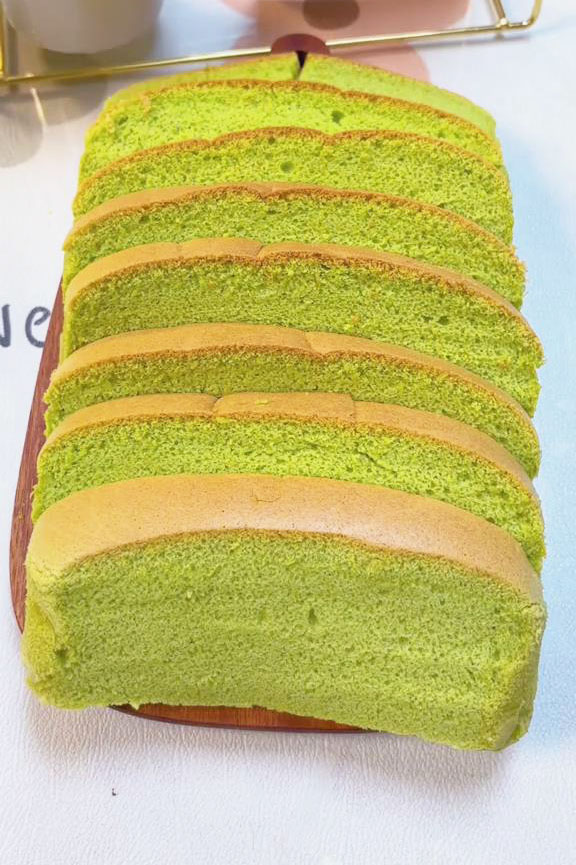
Aside from the pandan batter, the recipe calls for whisking egg whites with lemon juice and sugar to form stiff peaks. The technique of making these two types of mixtures gives you the familiar light, spongy, and fluffy texture we all love about pandan cake.
If you love pandan as much as I do, check out my pandan coconut jelly recipe as well.
Do you love baking and making desserts? Here are some yummy recipes you should check out:
- Watermelon Mochi
- Light & Creamy Swiss Roll (Plain & Black Tea Flavors)
- Creamy Strawberry Sandwiches (3 Ingredients Only!)
- Tang Yuan (Black Sesame Glutinous Rice Balls)
- Grass Jelly (Dessert With Drink)
- Snow Skin Mooncakes
- Homemade Taro Bubble Milk Tea
- Homemade Pineapple Cake
- Sachima (Chinese Soft Flour Pastry Cake)
- Chinese Coconut Pudding With Sago
- Pineapple Buns (Hong Kong Style Bolo Bao)
- 6-Ingredient Chinese Sponge Cake
- Milk Pudding With Coconut Shreds
- Soft And Sweet Red Bean Paste Buns
What To Know About The Ingredients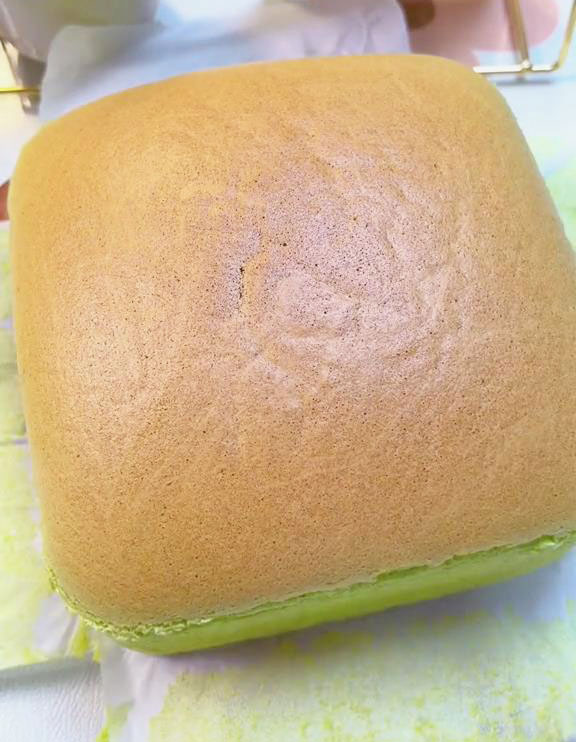
If you are new to baking or simply need more tips, don’t skip this section yet. Listed below are reasons why each ingredient is key in achieving a delicate pandan cake, as well as my top recommendations when it comes to alternatives. Read this before proceeding with the recipe steps.
- Low-gluten flour: Keep in mind that the more gluten there is, the firmer and chewier the cake will be. So, in order to achieve a light and delicate cake, you should use flour with a low gluten content. Examples of low-gluten flours are pastry or cake flour, barley flour, spelt flour, and rye flour. All-purpose flour is what I always use to make all kinds of buns, such as Bunny Steamed Buns, Piggy Buns, and Peach Buns. It’s perfectly fine, but it won’t be as light and crumbly as low-gluten flour. Avoid using special flours like tapioca flour or glutinous rice flour since this will result in an unideal texture.
- Pandan powder: Pandan powder is commonly bought in Asian markets or online stores like Amazon. Alternatively, you can use pandan juice, pandan paste, or even whole pandan leaves. When using pandan leaves, it should be blended with water until smooth. Then, the mixture is strained and squeezed to extract the juice, which you can now use for baked goods.
- Corn oil: Oil is essential in maintaining a soft and moist cake. I used corn oil, but you can use other types with a neutral taste, such as peanut, soybean, or vegetable oil. I don’t recommend melted butter since it makes the cake crumbly and firm after storing it in the fridge. This happens because butter firms up when cooled. On the other hand, oil does not firm up in the fridge and remains liquid, making the cake more flexible and crack-resistant.
- Egg yolk: Not only does oil contribute to moistness, but the egg yolks as well. A separate egg yolk mixture gives the cake a rich and moist texture because of the yolk’s fat content. The egg yolk is also responsible for keeping the cake’s structure stable. In order to separate the egg yolk from the egg white, crack the egg and pass the yolk back and forth using the egg shells until the egg white is fully separated. The egg yolk can also be separated by cracking it in a bowl and scooping it out with the cracked eggshell or suctioning it with a plastic bottle.
- Whole egg: A whole egg mixed with the egg yolk mixture simply keeps the balance for the entire batter.
- Coconut milk: For that tropical coconut taste, use coconut milk. If using coconut cream, this will be too thick, so you may have to adjust the amount since the batter you are going for in the end should be runny. The closest alternatives you can use are other plant-based milks such as soy and oat and simply add coconut flakes, shredded coconut, or coconut flavoring to still have that coconut flavor. However, it won’t be as rich as coconut milk.
- Egg white batter:
- Egg white: Egg white is essential in providing air and volume to the cake. It is whisked separately with lemon juice and sugar until it becomes frothy or foamy. It should form stiff peaks, meaning the mixture has firm tips that can stand up.
- Lemon juice: Lemon juice is needed in making the egg white frothy and firm. Moreover, lemon juice helps give the egg whites more structure and stability as you beat them. In place of lemon juice, you can use vinegar, tartar powder, or cream.
- Sugar: Another crucial technique in making the egg white foamy is gradually adding sugar. In this recipe, the sugar is added gradually in 3 increments. You can’t add the sugar all at once. Otherwise, the cake will collapse. You can use white granulated sugar or caster sugar.
- Egg alternatives: I know some of you may have egg allergies and are wondering how you can make this cake without it. Yes, it is still possible to make eggless pandan cake. All you need is a little help with baking powder or an egg replacer. Moreover, you just need a few tweaks for some ingredients like the egg white mixture. For instance, egg white can be replaced with 2 tablespoons of aquafaba for every 1 egg white. Then, simply add lemon juice and do the same steps for the sugar. Some recipes also incorporate plain yogurt for extra volume.
Baking 101: Pro Tips And Recommendations
Need a little help baking? Don’t worry—I got you! Check out these tips and recommendations for baking. Follow these do’s and don’ts to achieve the light and fluffy pandan cake texture.
- Weigh the ingredients: Baking requires measuring by weight, so make sure you have a kitchen weighing scale on hand. You don’t want to add too little or too much of the ingredients. Otherwise, the consistency will not be what you expected. If you think the consistency is off, simply adjust the texture by gradually adding flour or water in small amounts.
- Bring the eggs to room temperature: Make sure the eggs are not cold. Room-temperature eggs give a better consistency and are more stable. Moreover, cold eggs are harder to whip since they are more viscous. I suggest taking out the eggs from the fridge ahead of time when you are ready to bake.
- Sift the powdered ingredients: Sifting is a must! This separates large particles to reduce clumps. When there are clumps, you may end up excessively mixing the batter just to remove them, which may cause the batter to have too much air. Too much air in the batter will cause the cake to crumble.
- Do not overmix, just fold: Avoid overmixing the batter since you want it to have a fluffy, airy consistency. When mixing the two mixtures (pandan batter and egg white batter), it should only be folded using a silicone spatula. Overmixing with a whisk will remove the light consistency of the batter and reduce its volume.
- Use parchment paper in the cake pan: I know some may use grease or brush the cake pan with oil. However, this is not ideal for pandan cake since you want the cake to rise and adhere to the sides. If the sides are greasy, the cake may find it harder to rise since the sides are slippery. I prefer lining the entire cake pan with parchment paper from top to bottom. In this way, it is also easier for me to lift the cake out of the mold instead of inverting it.
- Remove excess air bubbles from the cake pan: After pouring the cake mixture into the cake pan, try removing air bubbles at the top. For air bubbles inside the mixture, simply lift the cake pan and drop it gently to pop them. You want to remove as many air bubbles as you can to have a smooth texture and avoid many holes.
- Preheat the oven with a baking tray filled with water: This technique is key in producing water vapor, which helps create a crisp outer layer. Moreover, it also helps regulate heat and distribute it in the oven.
- Let the cake cool after baking: This is a crucial step after baking. Do not open the oven door right away or you risk deflating the cake. So, make sure to let it cool for 5 minutes or more while unopened.
What To Prepare: Ingredients And Baking Tools
Here’s what you need to get started:
Baking Tools
- 2 bowls
- Strainer/sifter
- Kitchen thermometer
- Whisk
- Baking tray
- Electric whisk
- Silicone spatula
- Cake pan
- Parchment paper
- Cake knife
Ingredients
- 50 grams low-gluten flour
- 10 grams pandan powder
- 45 grams corn oil (heated to 70°C to 80°C)
- 4 egg yolks
- 1 whole egg
- 50 grams coconut milk
- 4 egg whites
- 1 tbsp lemon juice
- 50 grams white sugar
How To Make Pandan Cake In 10 Steps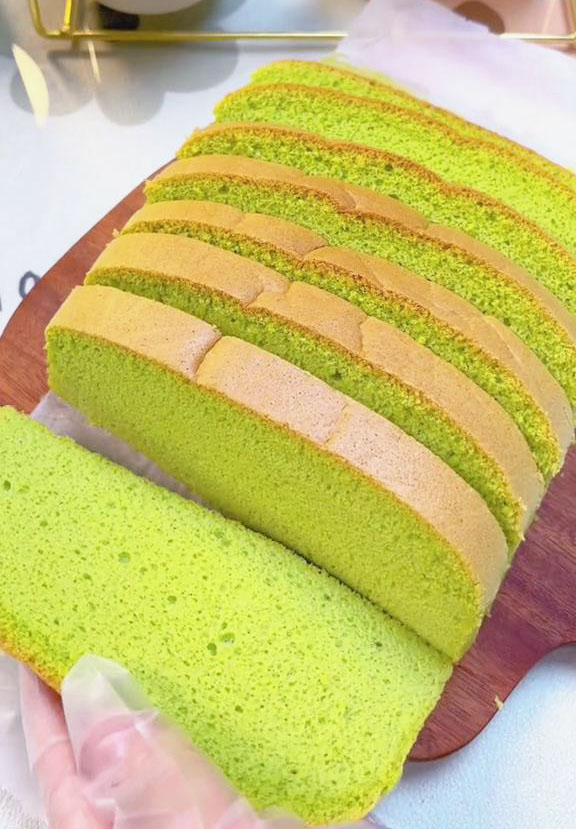
The key steps to remember here are making the pandan batter, whisking the egg white mixture, combining the two mixtures, and baking it in the oven. Baking time will take about an hour, so you have ample time to rest and clean up. Watch how I did with my Instagram or TikTok tutorial video.
What do you think of this pandan cake recipe? How did yours turn out? Share your experience by leaving a comment and tagging me @kitchenmisadventures.
- In a large clean bowl, sift low-gluten flour and pandan powder.
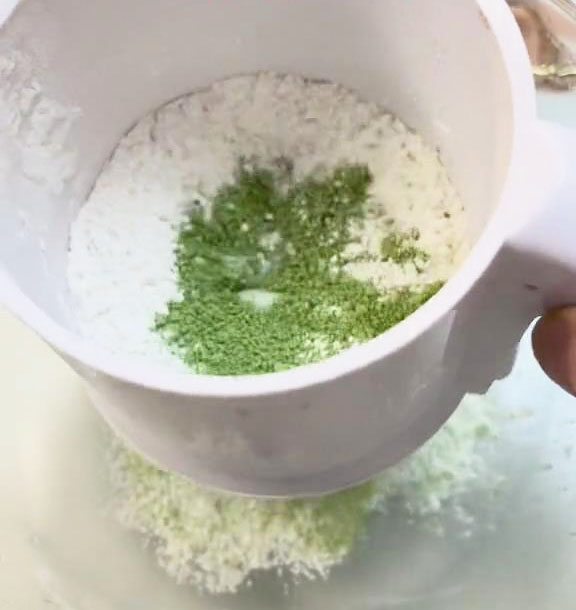
- Then, heat oil in the microwave for about 1 minute on high until it reaches 70°C to 80°C. Since every microwave works differently, I suggest adjusting the time based on your specific microwave’s performance. Slowly pour the heated oil into the dry mixture and stir until smooth.
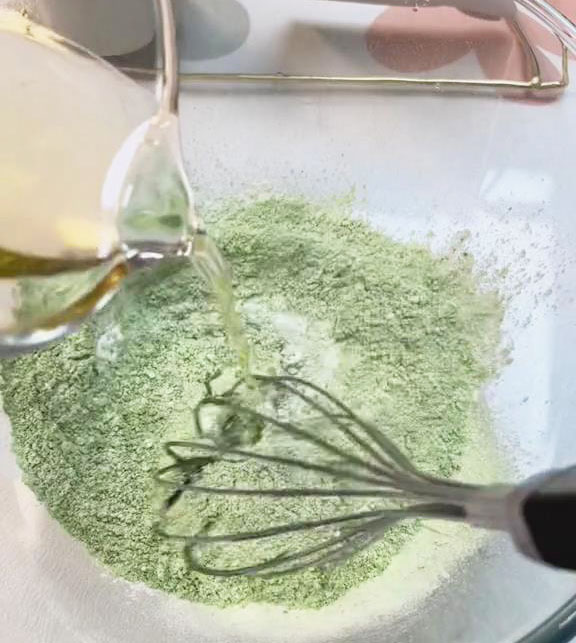
- Next, add 4 egg yolks and a whole egg, stirring until the batter becomes sticky, smooth, and even-colored.
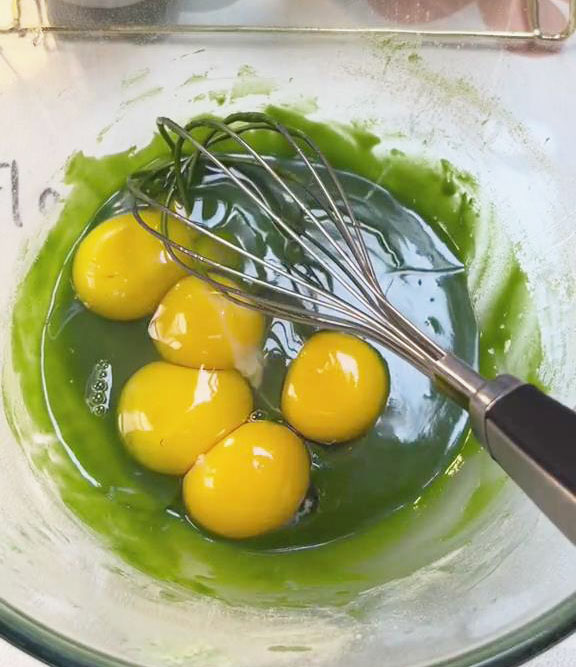
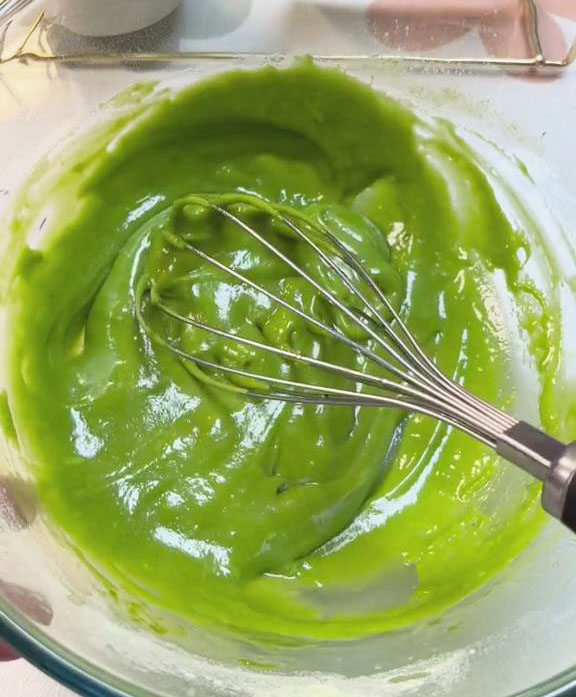
- Afterward, add coconut milk and stir again until well mixed. The batter should be relatively thin and runny. A thick consistency may cause the cake to crack, meaning it has too much flour or dry ingredients.
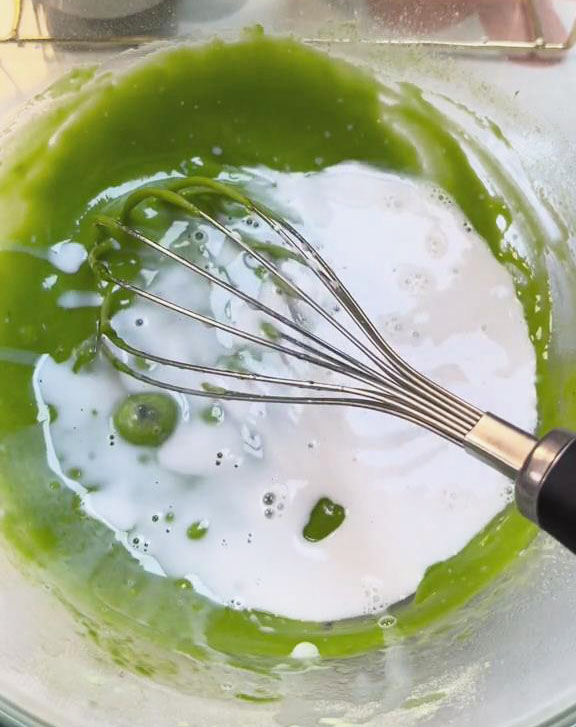

- Preheat the oven with a baking tray filled with water. I suggest using a large tray bigger than your cake pan.
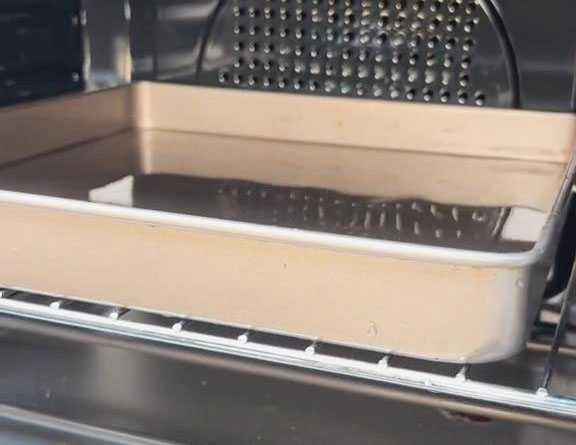
- In the meantime, make the egg white mixture. Beat 4 egg whites with a little lemon juice until big bubbles appear. Then, gradually add 50 grams of sugar in three portions. Continue whisking until the egg whites form stiff peaks. Stiff peaks are able to hold their shape when you lift the whisk from the mixture.
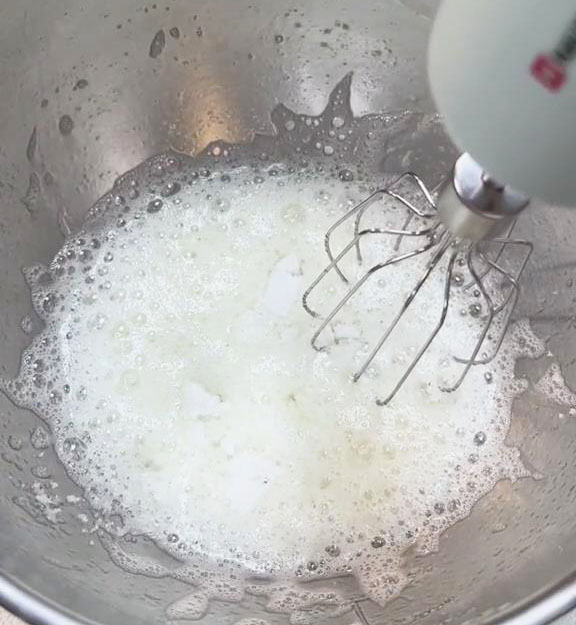
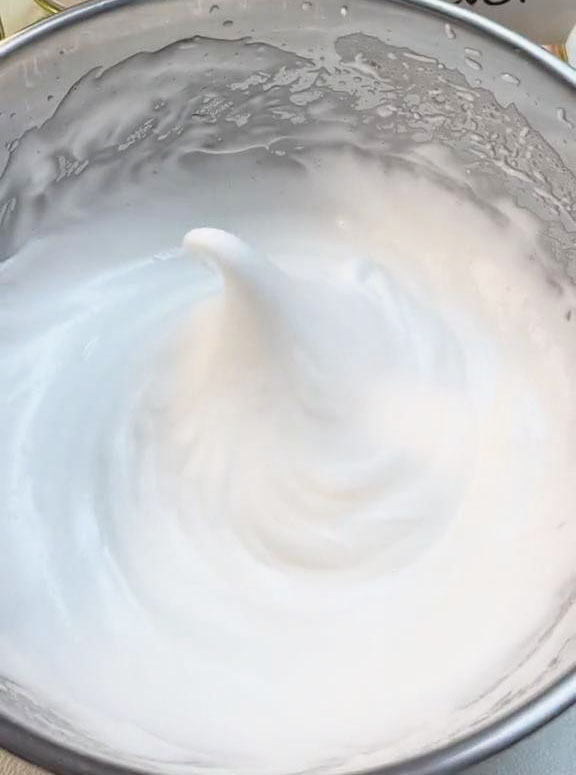
- Combine the pandan and egg white mixtures. Fold one-third of the egg white mixture into the pandan batter and mix gently. Then, fold in the remaining egg whites until well combined. Do not overmix this mixture since you want to maintain an airy, fluffy mixture. It should be runny but thick, creamy, and full of volume.
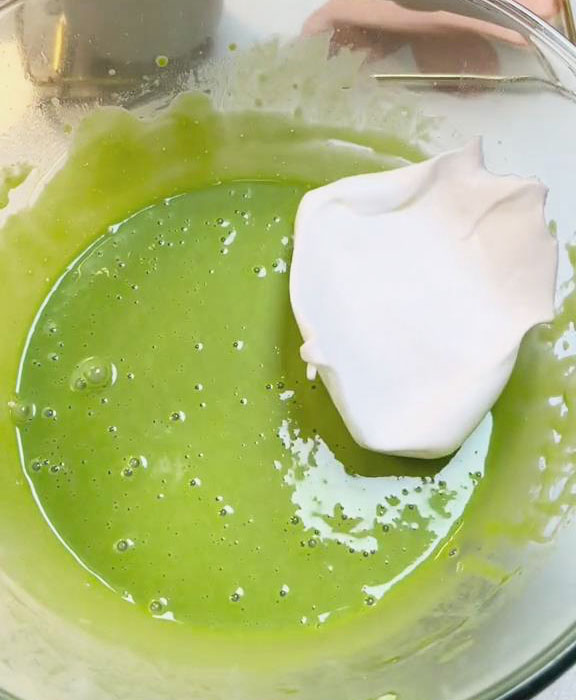
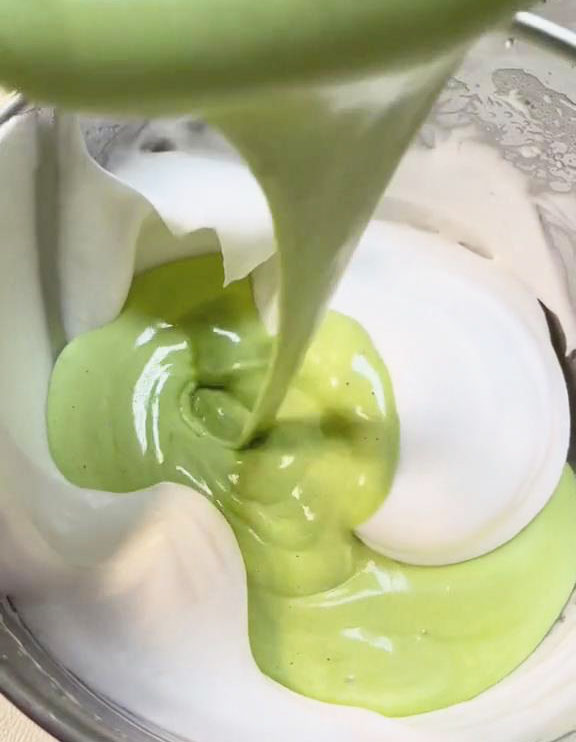
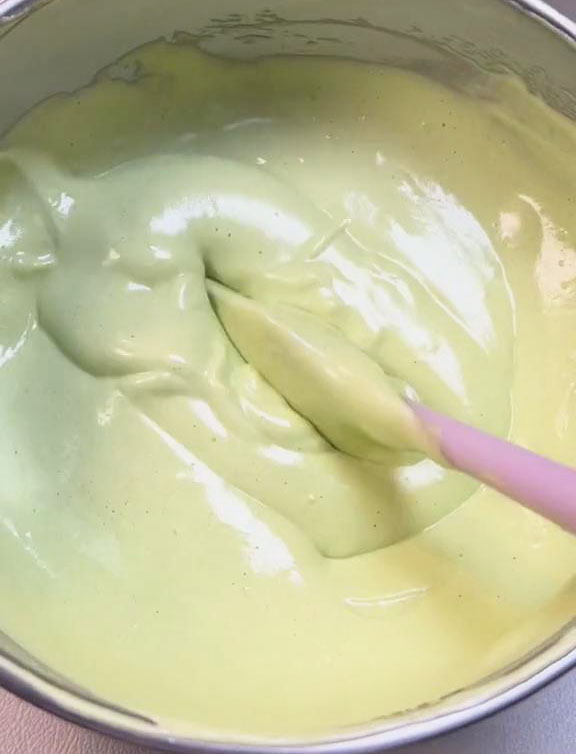
- Pour the batter into a cake pan lined with parchment paper, from top to bottom on all sides. Give the cake pan a gentle wiggle and drop to remove the air bubbles. You can also pop any visible air bubbles from the top.
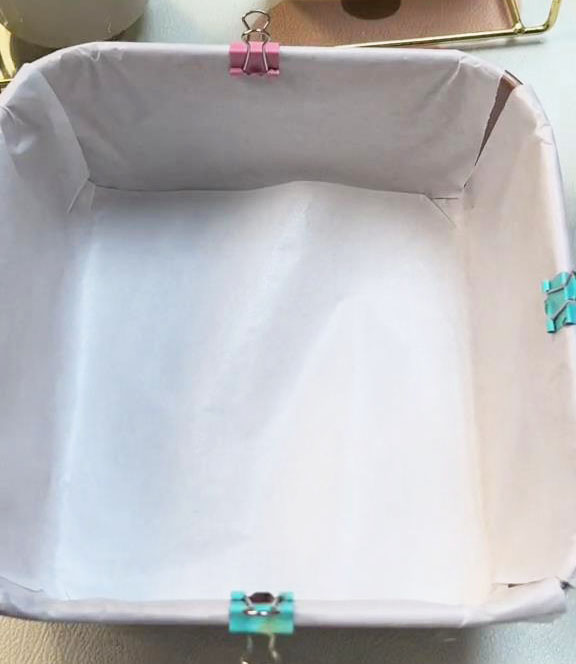
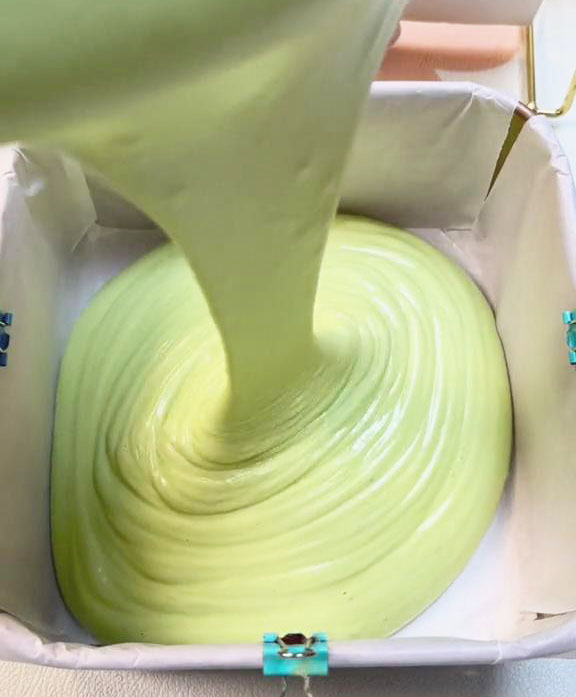
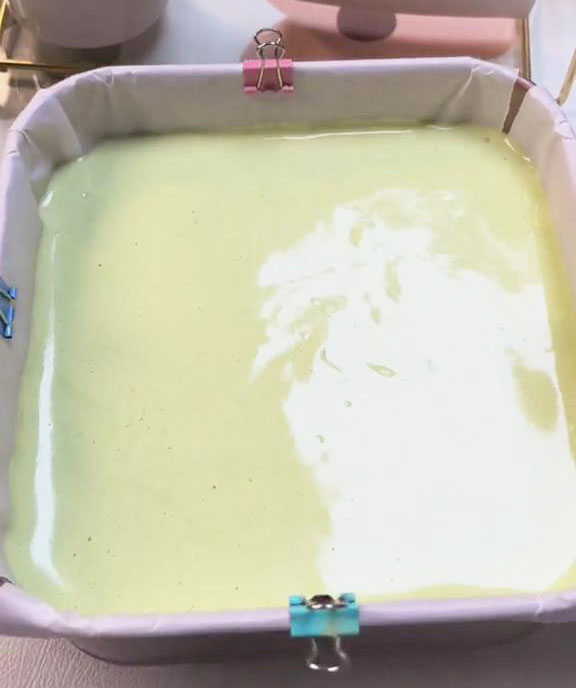
- Place the cake pan on top of the baking tray with water and bake in the preheated oven at 140 degrees Celsius for an hour.
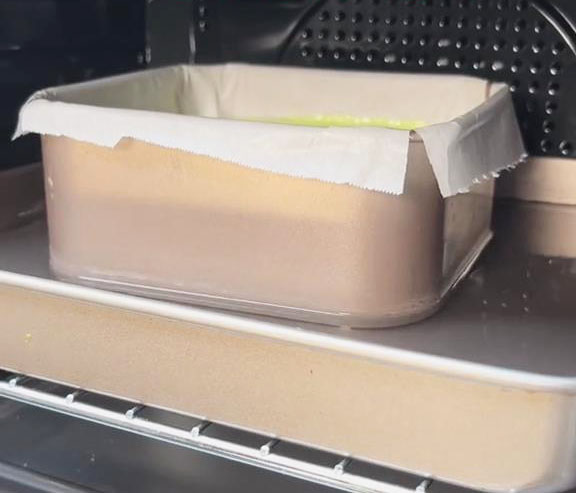
- After baking, let it cool in the oven for 5 minutes. Then, remove it from the oven and peel off the parchment paper. Allow it to cool completely before slicing and serving.

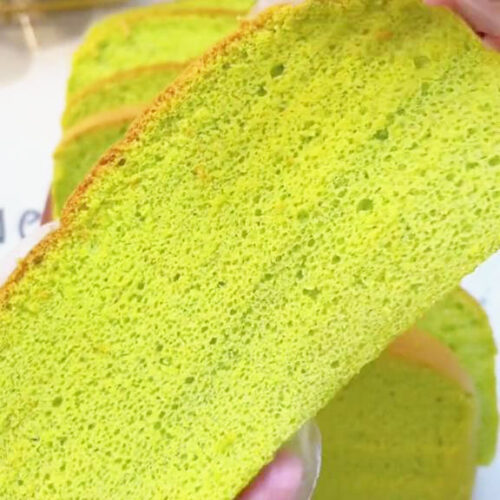
How To Make Light & Fluffy Pandan Cake
Looks intimidating, but making pandan cake is quite easy and fun! By following this recipe step-by-step, you get a light and fluffy cake with a delightful coconut and pandan taste. Make this cake for your tea time, after-meal dessert, or midday snack.Ingredients
- 50 grams low-gluten flour
- 10 grams pandan powder
- 45 grams corn oil heated to 70°C to 80°C
- 4 egg yolks
- 1 whole egg
- 50 grams coconut milk
- 4 egg whites
- 1 tbsp lemon juice
- 50 grams white sugar
Instructions
- In a large clean bowl, sift low-gluten flour and pandan powder.
- Then, heat oil in the microwave for about 1 minute on high until it reaches 70°C to 80°C. Since every microwave works differently, I suggest adjusting the time based on your specific microwave's performance. Slowly pour the heated oil into the dry mixture and stir until smooth.
- Next, add 4 egg yolks and a whole egg, stirring until the batter becomes sticky, smooth, and even-colored.
- Afterward, add coconut milk and stir again until well mixed. The batter should be relatively thin and runny. A thick consistency may cause the cake to crack, meaning it has too much flour or dry ingredients.
- Preheat the oven with a baking tray filled with water. I suggest using a large tray bigger than your cake pan.
- In the meantime, make the egg white mixture. Beat 4 egg whites with a little lemon juice until big bubbles appear. Then, gradually add 50 grams of sugar in three portions. Continue whisking until the egg whites form stiff peaks. Stiff peaks are able to hold their shape when you lift the whisk from the mixture.
- Combine the pandan and egg white mixtures. Fold one-third of the egg white mixture into the pandan batter and mix gently. Then, fold in the remaining egg whites until well combined. Do not overmix this mixture since you want to maintain an airy, fluffy mixture. It should be runny but thick, creamy, and full of volume.
- Pour the batter into a cake pan lined with parchment paper, from top to bottom on all sides. Give the cake pan a gentle wiggle and drop to remove the air bubbles. You can also pop any visible air bubbles from the top.
- Place the cake pan on top of the baking tray with water and bake in the preheated oven at 140 degrees Celsius for an hour.
- After baking, let it cool in the oven for 5 minutes. Then, remove it from the oven and peel off the parchment paper. Allow it to cool completely before slicing and serving.
Video
Nutrition
Calories: 616kcalCarbohydrates: 47gProtein: 18gFat: 40gSaturated Fat: 11gPolyunsaturated Fat: 9gMonounsaturated Fat: 18gTrans Fat: 0.1gCholesterol: 471mgSodium: 152mgPotassium: 257mgFiber: 1gSugar: 26gVitamin A: 638IUVitamin C: 3mgCalcium: 72mgIron: 3mgTried this recipe?Let us know how it was!

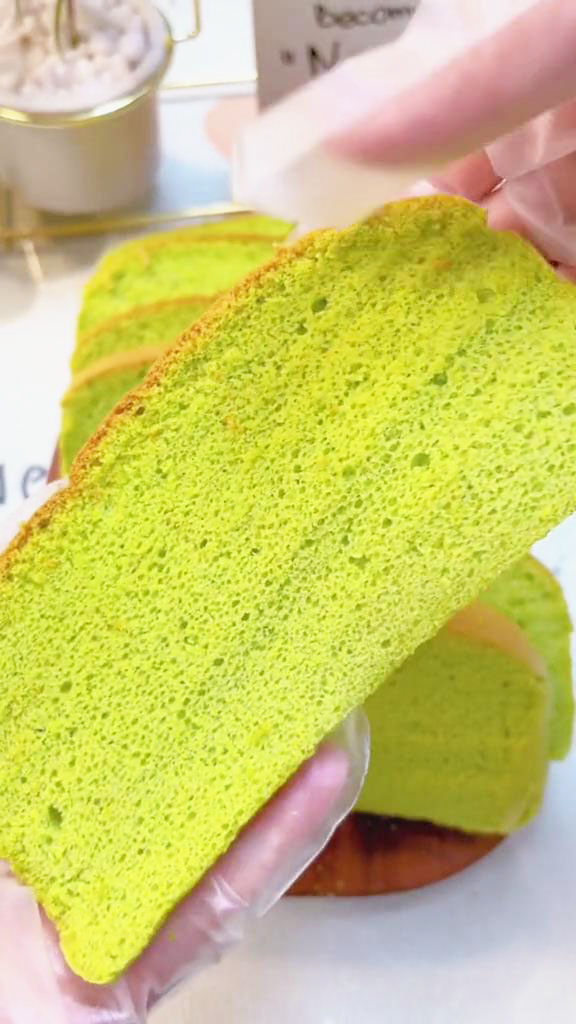
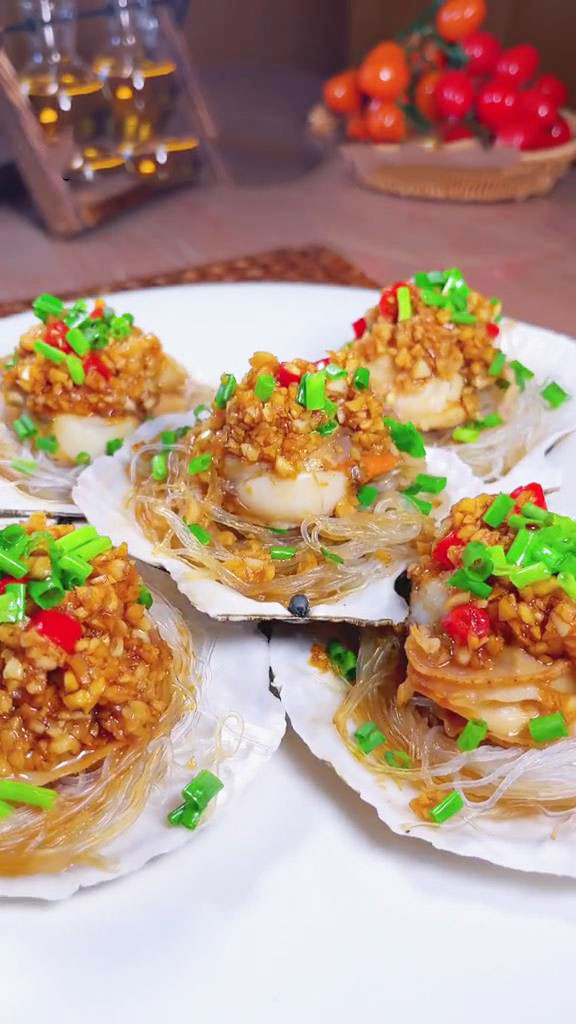
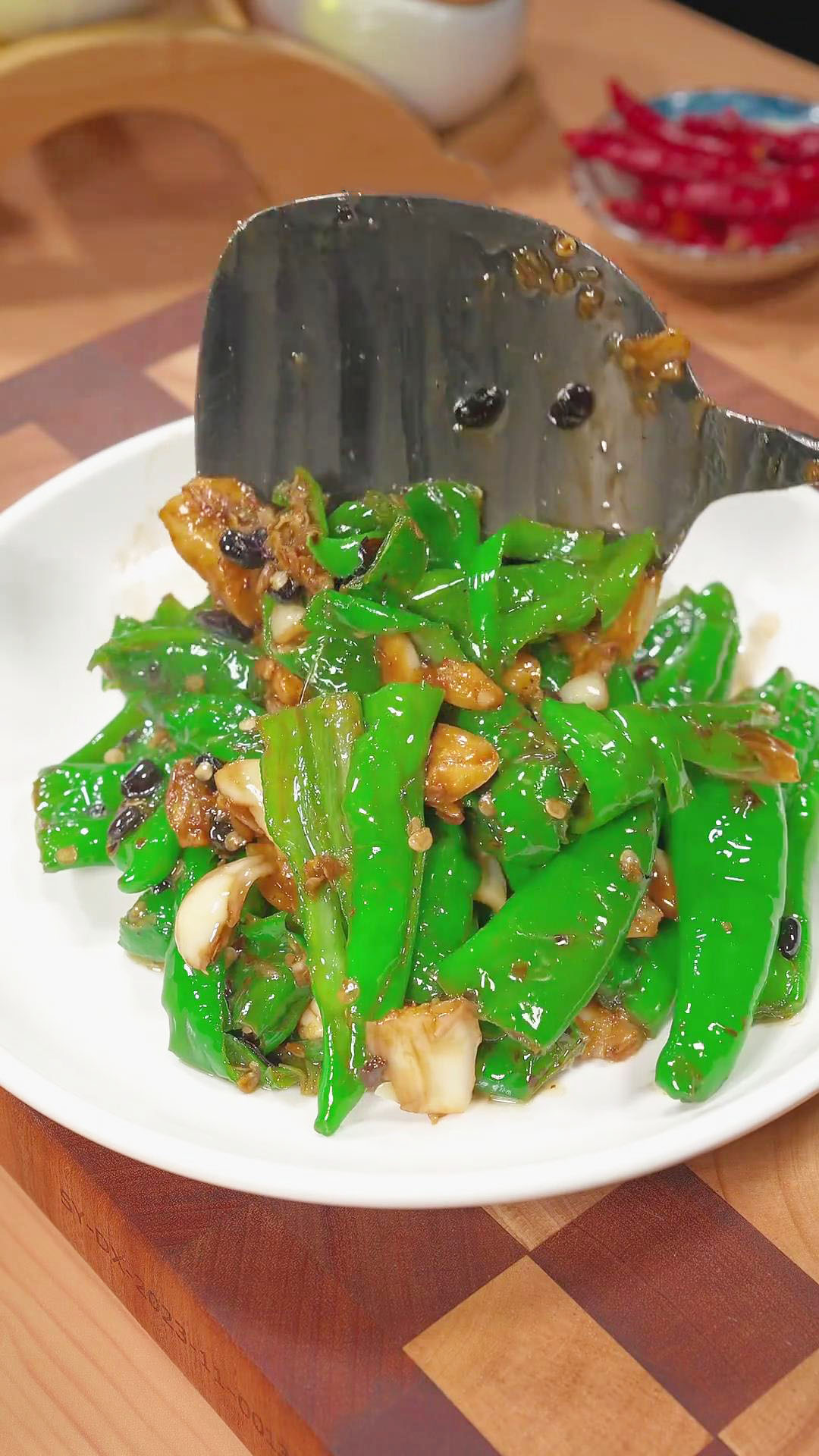
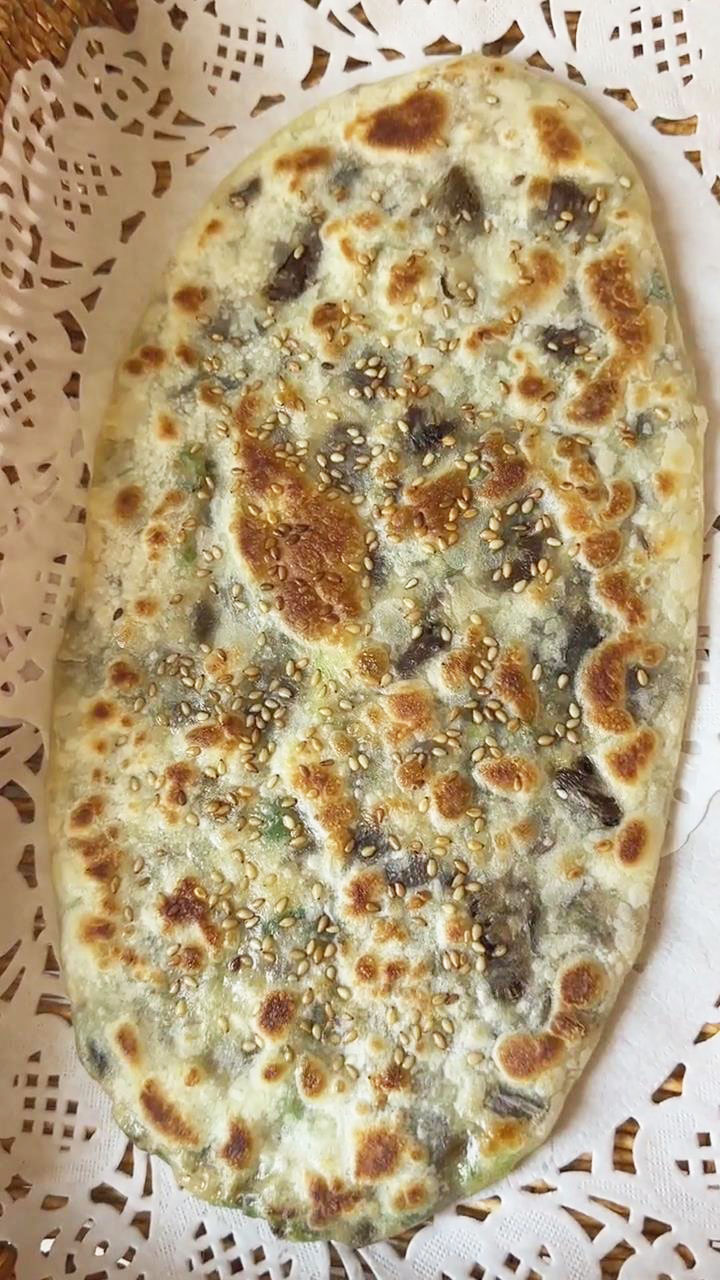
I made this Pandan Chiffon Cake gluten free in a loaf pan. The cake was perfect! I used King Arthur 1 to 1 gluten free flour and a 4.5″ by 9.5″ loaf pan.